
For bigger size photos you may click the 3-digit number.
| IN THE BEGINNING... It was just an ordinary hill close to the railroad tracks in Cajon Pass. A narrow fire-break road ran along the crest of the hill. For decades the hill had hosted an occassional railfan taking photographs of the trains. The hill's proximity to all three tracks made it an ideal location for railroad photography. I discovered this unique spot in the late 1980's, and it was my custom to set up a beach umbrella for shade. Photo #1 taken 7-7-91 shows me "railfanning California style" on what was to become known as Hill 582. I'm seated where the "drawbar memorial" stands today. Photo #2 (7-14-92): Following my first encounter with a rattlesnake on the sparsely vegetated hill, I retreated to the back of my 1965 GMC pickup truck. Photo #3 (10-92) shows several yuccas that still exist that I planted among the native plants on the east side of the hill in 1992. A UP W/B descends the Santa Fe north track. | ||
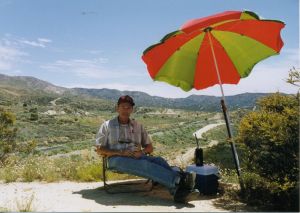 |
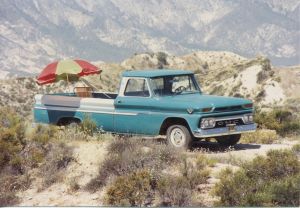 |
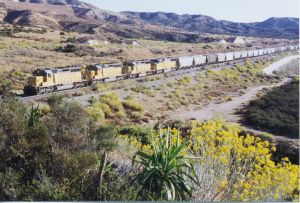 |
| 001 | 002 | 003 |
| Photo #4 (7-93) shows a yucca that still grows near north end of the Tony Andel memorial bench. The taller elm tree was our first tree, later destroyed by vandals. Photo #5 (11-93) shows the narrow road along the crest of the hill. The number plate mounted on the block signal at the northeast end of the hill reads 582A. Hill 582 was so named because of that signal number. Yes, it does occassionally snow on Hill 582, as evidenced by photo #6 taken on 2-20-94. | ||
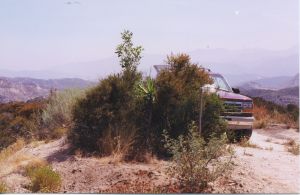 |
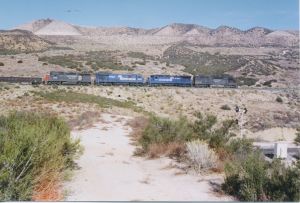 |
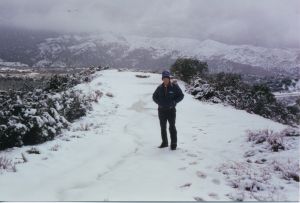 |
| 004 | 005 | 006 |
| Photo #7 (2-20-94): A Santa Fe manned helper-set pushes an E/B past the west side of Hill 582 on a cold, winter day. Photo #8 (5-9-94): The elm tree and yuccas on the east side are growing well. Photo #9 (5-12-94): My partner, Mike J., is shown preparing the ground for planting a locust tree. We planted two hybrid locusts on the west side in June 1994. A third locust tree was planted in August 1994. Only two survived. | ||
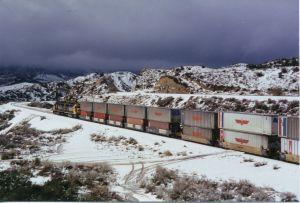 |
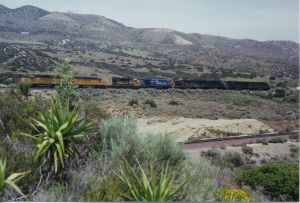 |
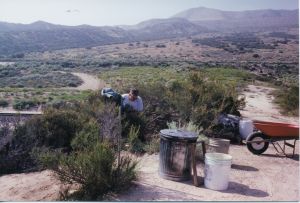 |
| 007 | 008 | 009 |
| Photo #10 (6-6-94): The "hilltender" with a one of the first two locust trees in the background. One of the two locusts soon died, and was replaced with a silver dollar gum tree which still exists. The yuccas also remain. Photo #11 (7-31-94) shows a pink-flowered oleander bush in the foreground that still lives beneath the Tony Andel memorial bench. The yuccas and the "caged" plant were moved to make room for Roy G's first red gum eucalyptus that was originally planted on the west side. That tree is now the tallest tree on the Hill. Mike's peppermint eucalyptus, visible in Photo #12 (7-31-94) with the tall stake, died, but the eucalyptus to the left remains. The metal trash can contains water for the bird-bath dripper which was installed in the summer 1994. A frequent target of vandals, the bird-bath was removed on August 17, 2005. | ||
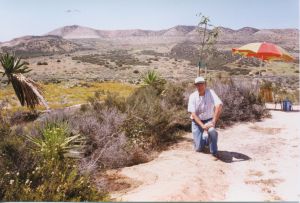 |
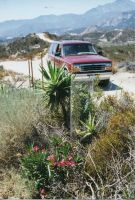 |
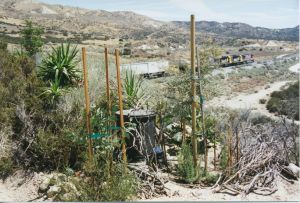 |
| 010 | 011 | 012 |
| Photo #13 (7-31-94) Battered by the wind, the tall yucca broke off, but the others remain on the west side. On the east side of the Hill, Photo #14 (7-31-94) shows the thriving peppermint eucalyptus that later died from the freezing cold. Castor bean plants and a "caged" tamarisk tree are also visible. The holes in the ground were to be planted with additional castor beans. Photo #15 (9-94) shows the castor beans that grew in the holes. A wooden retaining wall has now replaced the unstable rock wall. On 11-1-95 the castor bean plants and the two tamarisk trees were destroyed by USFS botanists. Both were considered to be "invasive" non-native plants. | ||
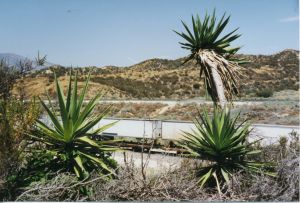 |
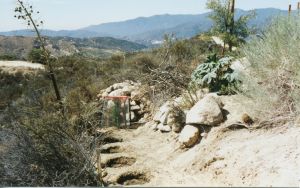 |
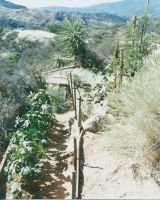 |
| 013 | 014 | 015 |
| Photo #16 (9-94) shows the original wood retaining wall that was built from donated scrap material during the summer of 1994. Soil composted with steer manure was used to fill behind the wall, providing an environment for thirsty tree roots seeking moisture. Eventually, the wooden wall was buried behind a taller, improved wooden wall. Another view of the original wood wall that replaced a stone wall that had collapsed is shown in Photo #17 (9-94). Photo #18 (9-94) is also a view of the original wall. Two short sections of the original wall are still exposed and visible at this time (5-2010). During a meeting in December 1995 at the Lytle Creek Ranger Station, the USFS botanists told us what we could and could not plant on Hill 582. A week later, the botanists came to the Hill and conducted a "walk-around" with me and my partner, Mike. Presently, everything growing on Hill 582 has been approved by Forest Service botanists. They asked us not to plant any more eucalyptus trees. They offered to donate pine trees IF we would transplant them from the Lytle Creek Ranger Station to Hill 582. Prior to the June 2002 brush fire, there were seven pine trees growing on the Hill. Only the three that remain on the Hill today survived the fire and the two-year fire closure imposed after the fire. | ||
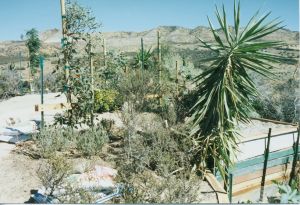 |
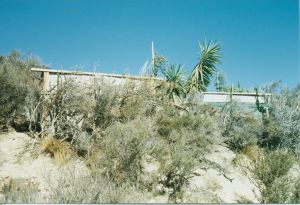 |
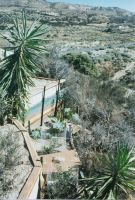 |
| 016 | 017 | 018 |
| Photo #19 (9-94) is another view of the east side. Note the yellow four o'clocks in bloom in lower left and then locate them in the two following photos for an overall perspective of the east side. Photo #20 (9-94): Mike planted three hybrid eucalyptus trees at the south end, east side. Only one of the three has survived, and that is the tree that now grows at the north end of the Chard Walker/Alray Tunnels memorial. One tree died and the other was removed by Mike to make space for a pine tree that the Forest Service botanists offered to donate. The remaining tree of the three was seriously vandalized in August 1998 and again in November 2007. It remains a survivor, as does Roy's red gum eucalyptus at the north end, east side that was also severely damaged in November 2007. We call it "Sue's Tree," named for Roy's late wife, Susan. Photo #21 (9-94) shows Mike's surviving eucalyptus on the left, the deceased peppermint eucalyptus in the center, and the eucalyptus that died is on the right edge of the photo. The Chard Walker/Alray Tunnels memorial now occupies the space in front of the peppermint eucalyptus. | ||
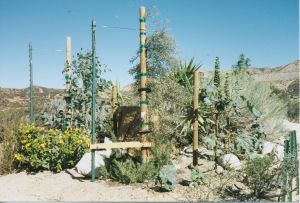 |
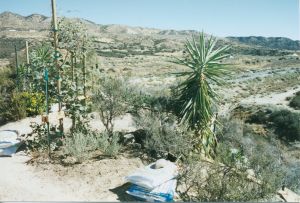 |
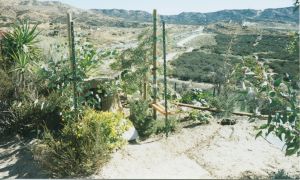 |
| 019 | 020 | 021 |
| Photo #22 (9-94) shows the east side of Hill 582 looking south. The oleander bush in the bottom center is still alive at that same spot under the Tony Andel memorial bench. The tamarisk tree in the wire cage lower left was destroyed by the Forest Service botanists. Photo #23 (9-94) is a close-up of one of the two tamarisk trees that were destroyed along with numerous castor bean plants. Photo #24 (7-31-94) shows the hybrid locust tree at the south end on the west side. The plastic container with lid holds water that drippers supplied to the locust trees throughout the summer. Later, that same container supplied water to the two Coulter pines growing on the west side that the Forest Service botanists donated to the Hill in January 1996. In 1995 a black locust tree with thorns was planted next to the south hybrid locust which has no thorns. That black locust was grown from seed from the black locust tree that remains alive at the site of the long-gone Summit Post Office. | ||
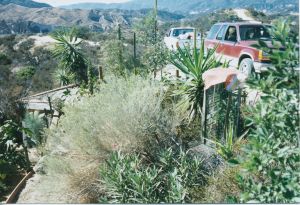 |
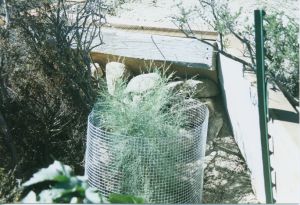 |
 |
| 022 | 023 | 024 |
| Photo #25 (7-31-94) featuring a classic Santa Fe E/B shows the young silver dollar gum that was planted August 1994 to replace the hybrid locust that perished. The gum tree, as well as all the other trees on the west side, was badly scorched in the June 17, 2002 brush fire. All the trees on the west side lost their foliage, but only the pine tree known as Ferne's tree at the northwest corner failed to survive. Ferne and her husband, Al, of Toronto, Canada were annual visitors to Hill 582 during those early years. Photo #26 (9-94) shows the north hybrid locust and the silver dollar gum just two months after being planted. Both trees were growing rapidly. Photo #27 (9-94) is a close-up of the silver dollar gum, which is said to be a difficult tree to grow. We didn't know that at the time. | ||
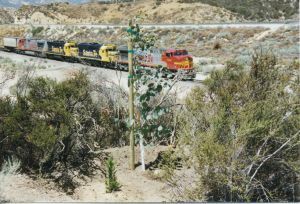 |
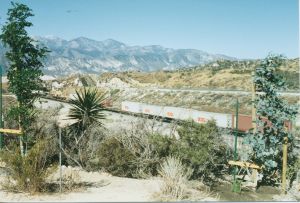 |
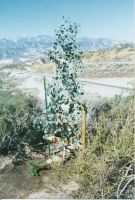 |
| 025 | 026 | 027 |
| Photo #28 (9-94) shows the two hybrid locust trees growing on the west side. Apparently the hybrids were grafted on to black locust root stock as an offshoot came up very close to the north hybrid. The offshoot grew vigorously and became the dominant tree. Black locust trees have white blossom clusters in the spring, while the hybrids produce red blossoms. In 2009 the hybrid portion of the north tree died, while the black locust offshoot continues to grow. Photo #29 (9-94): Southern Pacific rattlesnakes are the common variety in Cajon Pass. This SP rattler was roaming near the silver dollar gum. Rattlesnakes are common in Cajon Pass and on Hill 582. Extreme caution is advised April through October. Photo #30 (9-94) shows a pair of small rosemary plants inside circular rocks. Both survived the 2002 fire and are still very much alive behind the south end of the Chard Walker/Alray Tunnels memorial. | ||
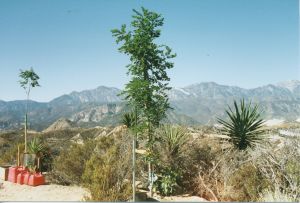 |
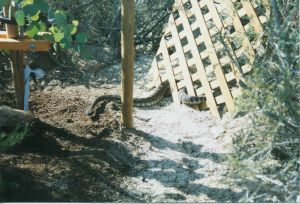 |
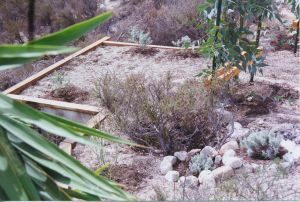 |
| 028 | 029 | 030 |
| Photo #31 (11-9-94): Eucalyptus tree at south end/east side that was removed to make room for "Tony's Christmas tree" that was planted December 25, 1996. Tony's tree, which was donated by Tony Andel and was left untouched by the 2002 fire, remains today at the south end of Hill 582. Tony's relatives donated the bench which is a memorial to Tony Andel - a life-long employee of the Santa Fe Railway. Photos #32/33 (10-24-04): Except for short periods during the 2-year fire closure in 2002-2004, the bird-bath dripped continuously from summer '94 until August 2005, when it was removed because of repeated vandalism. Forest Service personnel helped keep it dripping durng the fire closure. The bird-seed feeder was also established in 1994 and still remains in use. The wildlife, including quail and ground squirrels, are regular users of the bird-bath and feeder. | ||
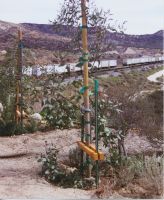 |
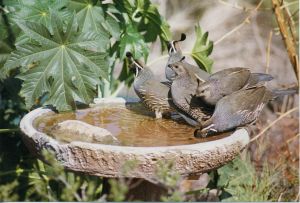 |
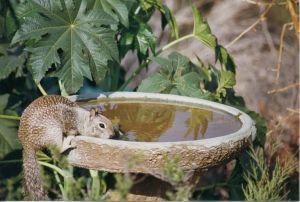 |
| 031 | 032 | 033 |
| Photo #34 (9-94) shows the east side of Hill 582. Photo #35 (9-94) is the west side. Photo #36 (10-94) shows the plants, trees and bird-bath on the east side. Large-leafed plants are castor bean plants which were later banned from the Hill by the Forest Service botanists. | ||
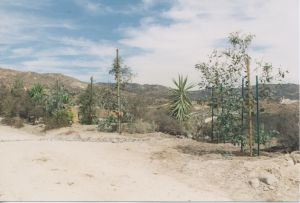 |
 |
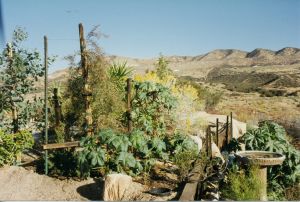 |
| 034 | 035 | 036 |
| Photo #37 is an over-all view taken in October 1994. We had begun to cover the road with small rock screened from the dirt that was used to fill in behind the retaining walls. Photos #38/39 show how much the trees had grown by November 5, 1994. | ||
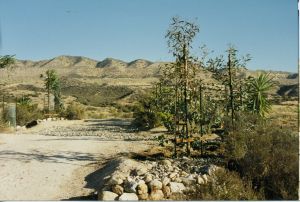 |
 |
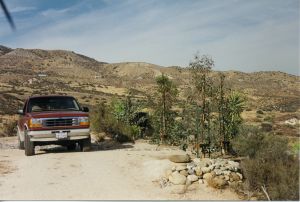 |
| 037 | 038 | 039 |
| Photo #40 (11-94) is a view of the west side of Hill 582 with the Santa Fe north track in the foreground. Photos #41/42 are views of the east side in November 1994. The trees on the Hill are becoming quite noticeable, but the Forest Service has so far ignored the development. | ||
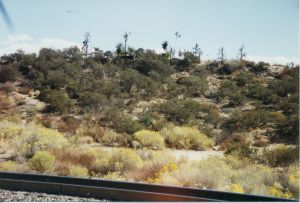 |
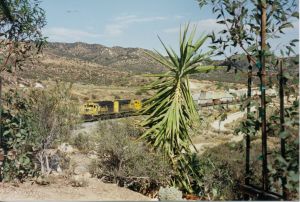 |
 |
| 040 | 041 | 042 |
| Photos #43/44/45 show the Hill in February 1995. The trees made it through the winter OK, but the yuccas are subject to frost damage every winter. The Forest Service botanists said the eucalyptus trees would freeze at that 3300 foot elevation, but that has not happened yet. | ||
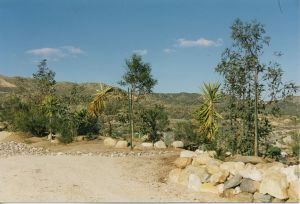 |
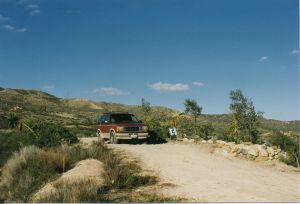 |
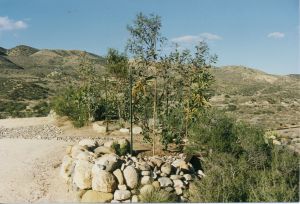 |
| 043 | 044 | 045 |
| Photo #46 (10-95): The trees and yuccas grew substantially during the summer of 1995. Photo #47 (10-95): A contractor working on the Santa Fe right-of-way roads using a front-end loader brought this bucket-load of dirt plus another load to the Hill. Mike and I screened out the rocks for covering the parking area before dumping the dirt behind the retaining wall then under construction on the east side. Photo #48 (10-95): A burning motorhome on the eastbound I-15 ignited a brush fire that burned down to the Southern Pacific tracks. While a helicopter made water-drops, hand crews kept the fire from crossing USFS road 3N53 and the SP tracks. The area was crawling with fire trucks and officials. We believe that is when Forest Service management noticed the trees growing on Hill 582. | ||
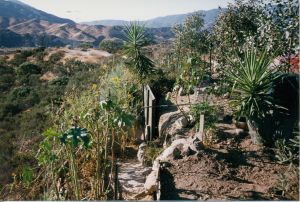 |
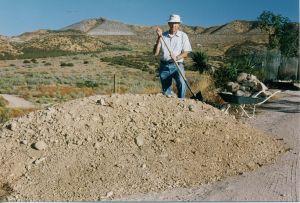 |
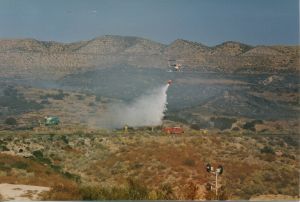 |
| 046 | 047 | 048 |
| Photo #49 (10-95): Not long after the fire, two Forest Service botanists, unannounced, destroyed two young tamarisk trees and several castor bean plants growing on the Hill. Wondering the reason for the destruction, Mike inquired at the Lytle Creek Range Station and was told that it is illegal to plant anything in the National Forest. Mike arranged for an early December meeting with the botanists at the USFS Lytle Creek headquarters. They agreed to allow Hill 582 to exist, and we were told what we could and could not plant on the Hill. A week later, the botanists met with us on the Hill for a "walk-around." They asked us not to plant any more eucalyptus trees, saying they would rather have pine trees instead. They offered to donate pine trees IF we would transplant the trees from Lytle Creek. On New Year's Day, 1996, Mike and I transplanted the "Melinda" pine tree, named for one of the botanists, that continues to grow on the west side between the two locust trees. A week later we transplanted another Coulter pine - the "Amy" pine tree - that remains alive near the southwest corner of the Hill. We also planted 5 additional pine trees, but the June 2002 brush fire destroyed 4 of them. Photos #50/51 (11-95): The empty planter boxes where the tamarisk trees had been growing. According to the botanists, some tamarisk trees are highly invasive and suck up a lot of moisture. Our tamarisks were grown from cuttings taken along the I-15 freeway. They were not the invasive variety. | ||
 |
 |
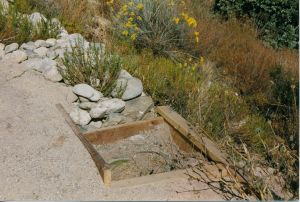 |
| 049 | 050 | 051 |
| Photo #52: East side view in November 1995. Photo #53 (11-95): Rock retaining wall built along north end, east side in October 1995. A Caterpillar front-end loader driver brought two loads of dirt to fill in behind the wall. Much of the rock wall collapsed during the heavy rains of the El Nino winter '97/'98. A wooden wall replaced the rock wall. Photo #54 (11-95) shows the wooden retaining wall to the right of the narrow walkway along the south end, east side. In October 1996 that wooden wall was buried behind a stronger and taller wooden wall, thus widening the walkway by an additional 2 feet. | ||
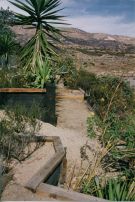 |
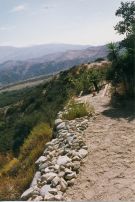 |
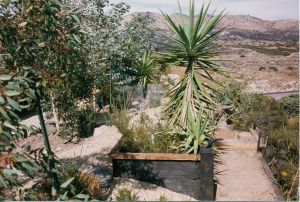 |
| 052 | 053 | 054 |
| Photo #55 (11-95): Note the pair of short metal fence posts lower right. The post remain in place and now support the bird-feeder post. Photo #56 (2-25-97): Rosemary plant in bloom on east side, south end that just up and died. Photo #57 (1-1-97): Planted on January 1, 1997, this is the 4th in a series of "New Year's Day" trees. This scrawny red gum eucalyptus at the north end, east side became known as "Sue's tree," in memory of Roy G.'s wife Susan. It was severely vandalized in November 2006, but has now partially recovered. According to an Australian railfan that frequents Hill 582, eucalyptus trees are nearly indestructable. California's eucalyptus trees were brought to the state from Australia by the Southern Pacific Railroad for use as railroad ties. The experiment failed, as eucalyptus wood splits easily. | ||
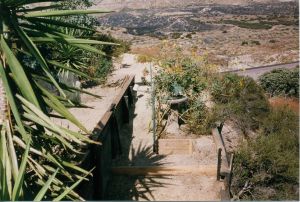 |
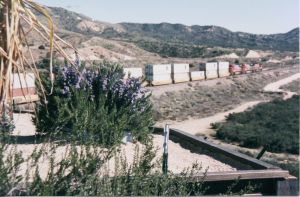 |
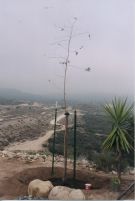 |
| 055 | 056 | 057 |
| Photos #58/59 (2-25-97) show the vegetation on the west side. Red and silver Santa Fe Warbonnets are rarely seen these days (May 2010) and manned blue and yellow helper sets are long-gone on Cajon. The classic view of the San Gabriel mountains from Hill 582 endureth forever! Photo #60 (12-96): The hilltender (left) and Roy G. wishing train crews Happy Holidays. | ||
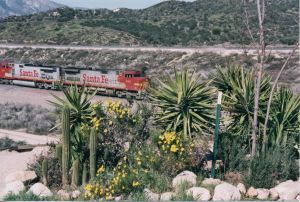 |
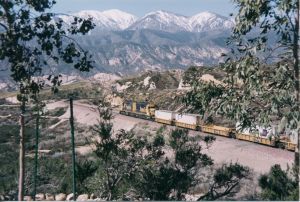 |
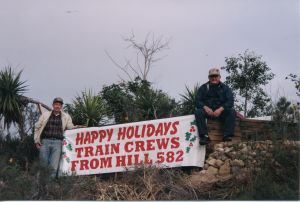 |
| 058 | 059 | 060 |
|
Photo #61 (12-96): Ron D. (left) had this sign made for display on the west side of Hill 582. Ron supplied a 12 volt auto battery, a solar panel to charge the battery, two 12 v. flood lights, and a refrigeration control that turned the lights on when the temperature dropped at night and turned them off in the morning when the temperature rose. The sign was mounted on the west retaining wall facing the tracks, and the system worked perfectly. A week after installation, the Forest Service ordered us to take the sign down. "We told you guys to keep a low profile, and that sign is not a low profile." Photo #62: The American flag flies over Hill 582 on Labor Day 2002 in this photo of the southeast end. Photo #63 (9-2000) shows the drawbar that Mike Marzlo and friends "planted" on the Hill on Memorial Day 2000. |
||
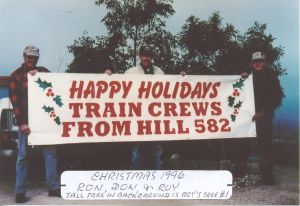 |
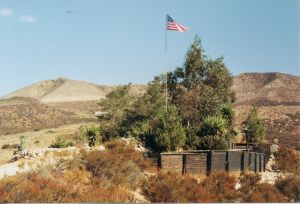 |
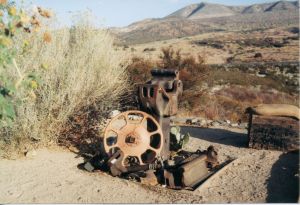 |
| 061 | 062 | 063 |
| Photo #64 (2-01) Heavy winter rains caused the rock wall at the southwest end to collapse. Photo #65 (5-01): The hilltender standing in front of the locust trees in full bloom in the spring of 2001. Photo #66 (5-01): Wildflowers in bloom along the northeast end of the Hill. The pine tree right of center was destroyed by the June, 2002 brush fire. | ||
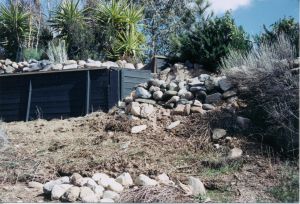 |
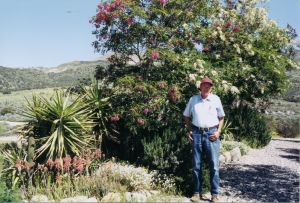 |
 |
| 064 | 065 | 066 |
| Photo #67 (5-01): Spring flowers and a BNSF E/B on north track. Photo # 68 (12-01): GGG and DET celebrating Christmas 2001. Note the decorated mini-tree in front of the Coulter pine that was donated by the Forest Service. Photo #69 (6-17-02 1:40 PM): Hill 582's darkest hour as a major brush fire approached the Hill from the south. View is of the west side from the SP tracks. | ||
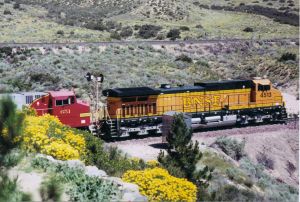 |
 |
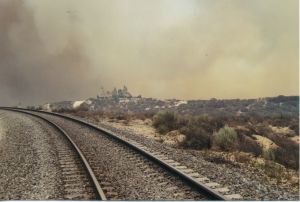 |
| 067 | 068 | 069 |
| Photo #70 (6-17-02 1:50 PM): The wall of flames has crossed the #2 (south) track and a strong southwesterly wind moves the flames rapidly along the ridge line towards Hill 582. Photo #71 2:10 PM): The fast-moving flames on the east side have already reached the northeast corner of the Hill, scorching the eucalyptus trees and a pine tree while also destroying two pine trees. Photo #72 (2:20 PM): A Forest Service technician and an unidentified railfan watch from the SP tracks. The west side had not yet burned, but shortly after this photo the flames started to move up the west side. A nearby fire dept. vehicle driver that was directing the aircraft water drops, told us we should leave. We retreated to the tunnels, waited a half hour, and then the Forest Service man went back towards the Hill to see if it was safe for us to be closer to the Hill. He soon returned to escort me back to the Hill. He said that while he was there, the pine tree on the northwest corner "exploded" from the heat and was rapidly destroyed. The wooden retaining wall was also on fire with the flames moving towards the north end. Later that evening, the fire burned west to the tunnels. When I drove in the next morning to check on Hill 582, the fire was still burning along the SP tracks near the tunnels. | ||
 |
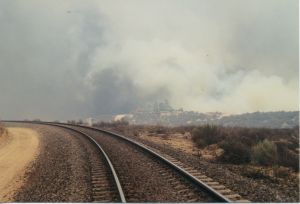 |
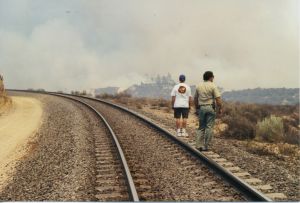 |
| 070 | 071 | 072 |
| Photo #73 (6-18-02): Miracles do happen! This is a view of the east side taken the next morning. Hill 582 had survived. Photo #74 (6-18-02): "Ferne's Tree" - a pine tree that was donated by Ferne and Al W. of Toronto, Canada died in the flames. Photo #75 (6-18-02) shows the fire damage on the west side. All the trees on the west side were scorched, causing them to drop their foliage. Except for Ferne's tree, all the westside trees, including the two Coulter pines, put on new foliage during the summer months. The locust trees even bloomed again. The yuccas took a beating, but they all lived, as did the Desert Bird of Paradise bush that came back up from the roots. | ||
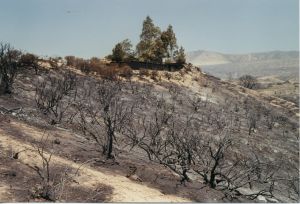 |
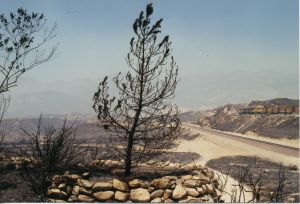 |
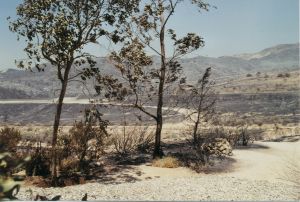 |
| 073 | 074 | 075 |
| Photo #76 (6-18-02): Ferne's tree and Roy's red gum eucalyptus #2 at northwest end of the Hill. Photo #77 (6-18-02): Both pine trees at the northeast end of the Hill were destroyed along with two large manzanita bushes. According to Cajon Pass historian, Chard Walker, the area surrounding Hill 582 last burned in 1964. Photo #78 (6-18-02): A very old and very dead manzanita at the northeast end of the Hill. | ||
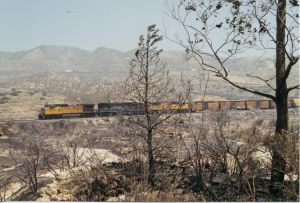 |
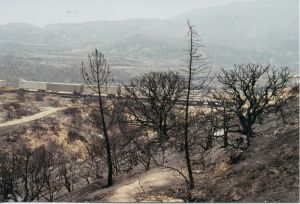 |
 |
| 076 | 077 | 078 |
| Photos #79/80 (6-18-02): West side of Hill 582 following the fire. Photo #81 (6-18-02): The fire-damaged west side wooden retaining wall. | ||
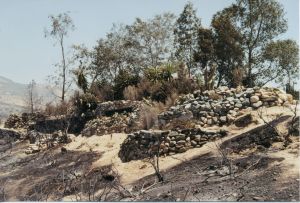 |
 |
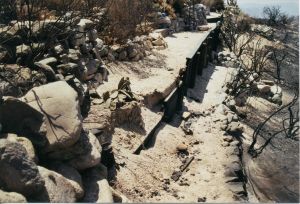 |
| 079 | 080 | 081 |
| Photo #82 (6-18-02): Wooden retaining wall on east side that was partially burned the previous day. The scorched pine tree behind the wall eventually died. Photo #83 (8-6-02): By August, the locust trees had fully recoved and were blooming for the second time. Photo #84 (8-6-02): Overall view of the south end of Hill 582. | ||
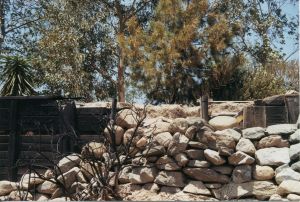 |
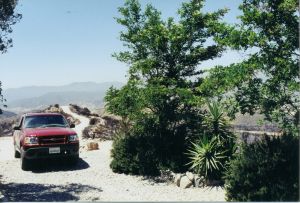 |
 |
| 082 | 083 | 084 |
| Photo #85 (8-6-02): BNSF E/B, scorched earth on west side of Hill 582, the "Amy" pine tree on the left and a beautiful cactus blossom lower right. Photo #86: The repaired rock wall, northeast end, July 2003. Photo #87: The rebuilt rock walls, southwest corner, October 2003. The green fabric cage protects a tall cactus from freezing. Later on, vandals with shotguns destroyed the cactus. | ||
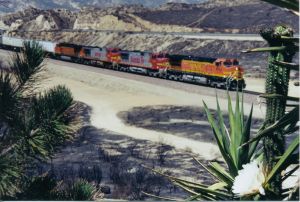 |
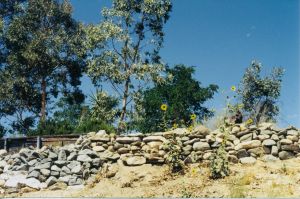 |
 |
| 085 | 086 | 087 |
| Photo #88: View of the south end of the Hill October 2003. Photo #89: The drawbar and Hill 582 marker in February 2004. Photo #90: A piece of rail and a plaque in memory of Michael John Marzlo were added in March 2004. | ||
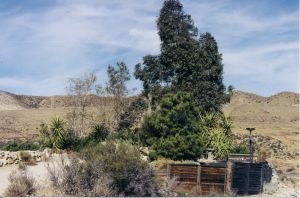 |
 |
 |
| 088 | 089 | 090 |
| Photo #91 (3-31-04): East retaining wall, south end that existed until March 2010 when it was "buried" behind a new wooden wall. Photo #92 (4-16-04): East wooden retaining wall, north end, was partly covered by a rock wall after the 2002 fire that ignited the wood wall. Photo #93 (4-20-04): Center section of the east wall with rock wall protection. | ||
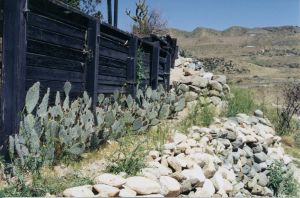 |
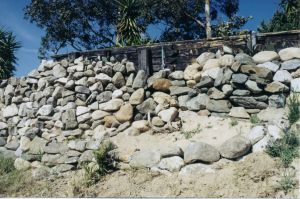 |
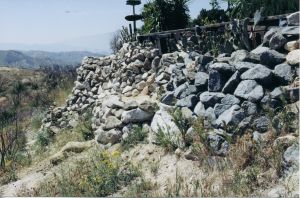 |
| 091 | 092 | 093 |
| Photo #94 (4-27-04): The hilltender standing next to a Spanish broom in full bloom at southeast corner of the Hill. A few months later, the Forest Service declared it an "invasive" plant, and the plant was removed. Photo #95 (11-04): Partially "buried" wooden wall at south end, east side that is now hidden by new wooden wall built in March 2010. Photo #96 (11-04) Wood retaining wall which is now hidden by new wooden wall. North of the bird feeder, the wood wall is now "buried" behind a rock wall. | ||
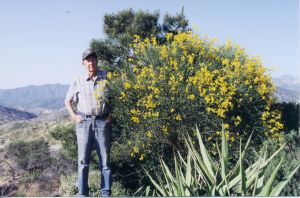 |
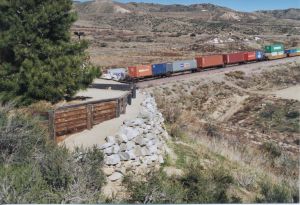 |
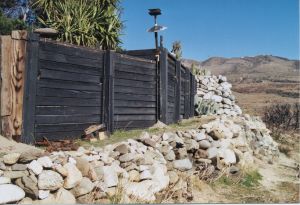 |
| 094 | 095 | 096 |
| Photos #97/98 (11-22-04): An autumn snow storm covers Hill 582 with some serious snow. Photo #99 (12-04) The east wall is now fully protected by a continuous rock wall, but it lasted for barely a month. | ||
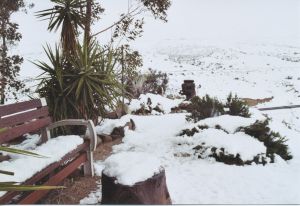 |
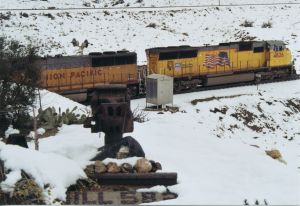 |
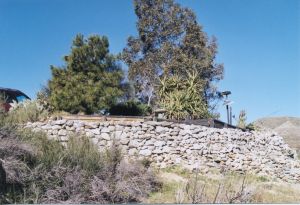 |
| 097 | 098 | 099 |
| Photos #100,101,102: Heavy rainfall in January 2005 caused portions of the east side rock wall to collapse. The rock wall was never rebuilt, and the rocks were used to reinforce and expand the rock wall center section and north end on the east side. While these rocks are all "native" to Cajon Pass, most of them were brought in from the middle area of the Pass. | ||
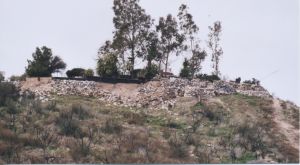 |
 |
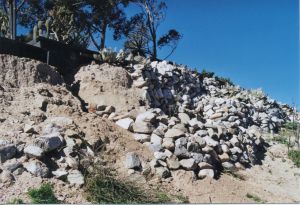 |
| 100 | 101 | 102 |
| Photo #103 (1-05): Another view of the collapsed east wall. Photo #104: It's the 4th of July 2005 on Hill 582. Photo #105 (4-9-06): From the left, Chard Walker, Don the Hilltender, Karl J. - the "Chicago Kid" and Gary G. aka GGG. | ||
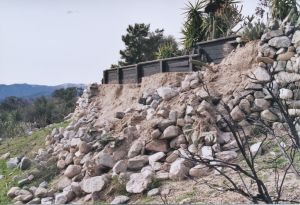 |
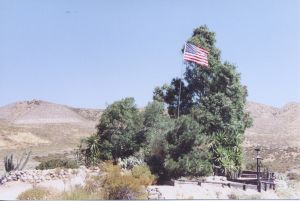 |
 |
| 103 | 104 | 105 |
| Photo
#106: Hill 582 on April 9, 2006. The east wooden retaining wall has been
mostly buried behind fill dirt that was brought in a bucket at a time
using 5 gallon buckets. Hundreds of buckets of dirt were needed. Photo
#107 (10-15-06): A rock-mounted brass plaque honoring Dave Burton and Ed
Delvers has been added to the "drawbar memorial" on the right
side. On the ground left of the drawbar is the Mike Marzlo plaque, and
mounted on a tie-plate behind the Mike Marzlo plaque is a brass plaque
honoring William B. "Bill" Garner. Photo # 108: West side view
of the Hill taken in November 2006. It looks about the same today - May 2010. |
||
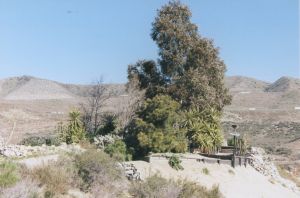 |
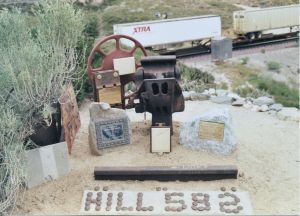 |
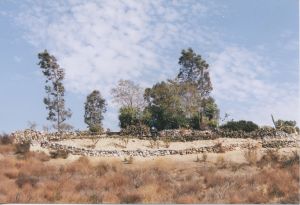 |
| 106 | 107 | 108 |
Copyright by Don E. Toles (with
permission Werner Meer)
Go back to Hill 582 Main Page - click here
Did you see Hill 582 - The Late Years? - click here

|
8 different and detailed Maps of Cajon Pass with
captions (Mile Posts and Location) by Gary G. Gray - click
here New 8/11: Maps "How to find" Hill 582, Sullivan's Curve, Noisy Point by Gary G. Gray - click here |
| Accurate Map of Cajon Pass with 3rd Main Track by Michael Amrine - click here |